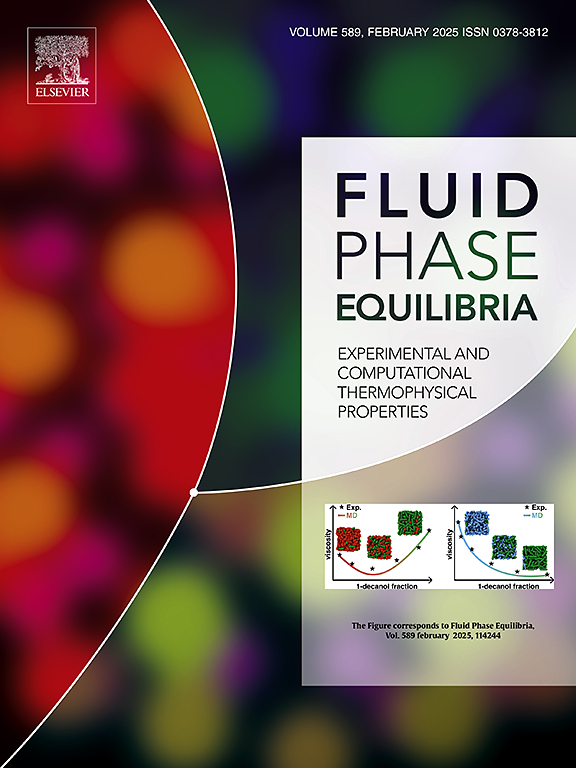Thermal and mutual diffusivities in binary mixtures of alkanes with dissolved gases by dynamic light scattering (DLS)
IF 2.8
3区 工程技术
Q3 CHEMISTRY, PHYSICAL
引用次数: 0
Abstract
This work presents thermal diffusivities a and Fick diffusion coefficients D11 of binary mixtures of the alkanes n-pentane, n-decane, n-hexadecane, or squalane (2,6,10,15,19,23-hexamethyltetracosane) with dissolved carbon dioxide (CO2) or propane by dynamic light scattering (DLS). The investigations are performed over a temperature range from (293 to 393) K and cover a wide composition range from infinite dilution of the dissolved gas up to an amount fraction of the gas of 0.69. Using DLS, D11 and a are accessed with average expanded experimental uncertainties (coverage factor k = 2) of (6.6 and 7.6)%. The results from this work are compared to the few experimental data available in the literature and are used to investigate the influences of the thermodynamic state and of the characteristics of the solvent and solute molecules on both transport properties. For all investigated binary mixtures, the influence of the dissolved gas on a is found to be small since most data agree with a of the pure solvent within combined uncertainties. The composition-dependent trend for D11 varies strongly for the different binary mixtures, where both an increase or decrease with increasing amount fraction of the dissolved gas can be observed. For D11 at infinite dilution, two prediction models from the literature are tested. While both models are able to qualitatively predict the temperature-dependent trend of D11, the relative deviation of the predicted D11 from the present experimental results varies strongly for the different mixtures between (9 and 95)%.

求助全文
约1分钟内获得全文
求助全文
来源期刊

Fluid Phase Equilibria
工程技术-工程:化工
CiteScore
5.30
自引率
15.40%
发文量
223
审稿时长
53 days
期刊介绍:
Fluid Phase Equilibria publishes high-quality papers dealing with experimental, theoretical, and applied research related to equilibrium and transport properties of fluids, solids, and interfaces. Subjects of interest include physical/phase and chemical equilibria; equilibrium and nonequilibrium thermophysical properties; fundamental thermodynamic relations; and stability. The systems central to the journal include pure substances and mixtures of organic and inorganic materials, including polymers, biochemicals, and surfactants with sufficient characterization of composition and purity for the results to be reproduced. Alloys are of interest only when thermodynamic studies are included, purely material studies will not be considered. In all cases, authors are expected to provide physical or chemical interpretations of the results.
Experimental research can include measurements under all conditions of temperature, pressure, and composition, including critical and supercritical. Measurements are to be associated with systems and conditions of fundamental or applied interest, and may not be only a collection of routine data, such as physical property or solubility measurements at limited pressures and temperatures close to ambient, or surfactant studies focussed strictly on micellisation or micelle structure. Papers reporting common data must be accompanied by new physical insights and/or contemporary or new theory or techniques.
 求助内容:
求助内容: 应助结果提醒方式:
应助结果提醒方式:


